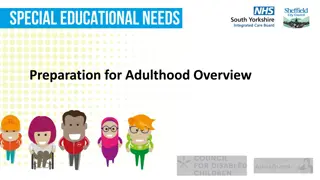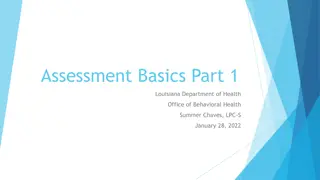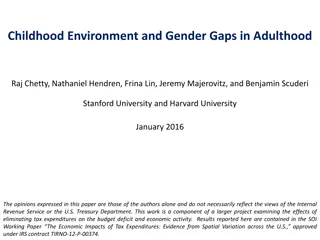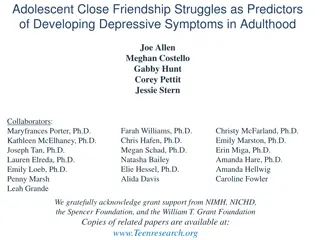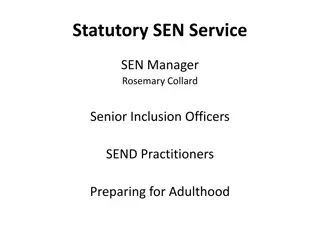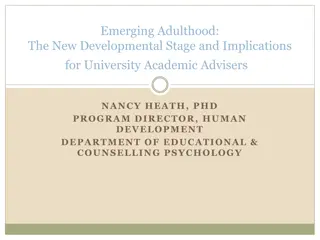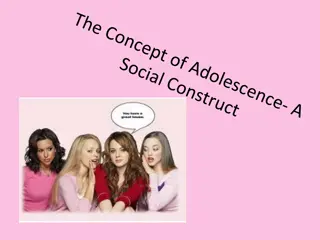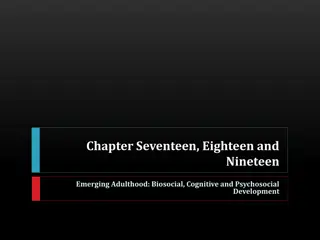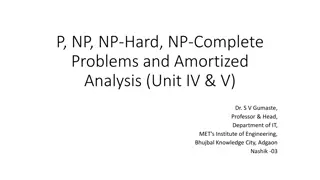Health Needs and Problems of Adulthood
Adulthood is defined by full size and strength, with three stages - early, middle, and late adulthood. Physical development in adults varies across different stages, impacting overall health and well-being. Addressing health issues in young adults is important to promote long-term wellness and prevent chronic diseases. As individuals age, changes in physical capabilities occur, highlighting the importance of healthy lifestyle choices and healthcare management in middle and late adulthood.
Download Presentation

Please find below an Image/Link to download the presentation.
The content on the website is provided AS IS for your information and personal use only. It may not be sold, licensed, or shared on other websites without obtaining consent from the author.If you encounter any issues during the download, it is possible that the publisher has removed the file from their server.
You are allowed to download the files provided on this website for personal or commercial use, subject to the condition that they are used lawfully. All files are the property of their respective owners.
The content on the website is provided AS IS for your information and personal use only. It may not be sold, licensed, or shared on other websites without obtaining consent from the author.
E N D
Presentation Transcript
Health Needs and Problems of Childhood, adolescence & adulthood adulthood CHS 232 Lecture 7 Mrs. Lamis Al-Sayyari
Adulthood Definition of the word adult: Having attained full size and strength; grown up; mature A person who is fully grown or developed. There are three stages of adulthood: early adulthood, middle adulthood, and late adulthood
Physical Development of Adults Physical Development of Adults Because of the dramatic physical developments that take place in adolescence, it may seem that less attention is placed on physical development in the adult years.
Physical Development of Early Adulthood Adulthood Early Early adulthood takes place roughly between the ages of 20 to 35. In early adulthood, a person may continue to add a bit of height and weight. Hormonal changes also continue to occur, but the effects are less pronounced than they were during adolescence. In terms of physical development, this period is the least dramatic.
What are young adult health issues The health care issues of young adulthood largely mirror those of adolescents. Relative to older age groups, young adults are generally very healthy and rates of chronic disease are low. As with adolescents the major health issues relate to behaviors such as substance use, sexual behavior, driving habits, diet and exercise that influence health in the short and/or long term.
Physical Development of Middle Adulthood Adulthood Middle Takes place roughly between the ages of 35 and 65. In middle adulthood, we may start to see more noticeable changes again. One of the most noticeable changes is the loss of skin elasticity. In middle adulthood, women will also go through a process called menopause and lose the ability to reproduce
Physical Development of Late Adulthood Late Adulthood At some time around the age of 65, we enter the world of late adulthood. More profound negative effects of aging will begin to take its toll on seniors bodies.
Physical Development of Late Adulthood Adulthood Late This is the final stage of physical change. Those wrinkles will become more noticeable and development of brown age spots on the skin starts to develop. Reaction time begins to slow
Psychological and Emotional Development of Adults
Psychological and Emotional Psychological and Emotional Development of Adults Development of Adults In early adulthood, these changes are going to be more noticeable than the physical ones. Finding one s place in the world. Independence -> independent choices -> emotional consequences -> impact on one s view of who he is.
Psychological and Emotional Psychological and Emotional Development of Adults Development of Adults Important life decisions are made about collage and career. Marriage and family formation typically occurs during early adulthood. Emotional and psychological well-being is often tied to how successful they are at forming these relationships.
What are young adult health issues Compared to adolescents, for example, young adults have higher rates of substance use, including alcohol, tobacco and marijuana use, and drinking and driving, as well as higher rates of obesity, motor vehicle crash mortality.
Psychological and Emotional Psychological and Emotional Development of Adults Development of Adults Now that we are leaving early adulthood, it is time to face that midlife crisis! During middle adulthood, adults go through a whole other set of stressors: Perception of who they have become.
Psychological and Emotional Psychological and Emotional Development of Adults Development of Adults
Psychological and Emotional Psychological and Emotional Development of Adults Development of Adults Parent-child relationships begin to change as children grow up, and becoming caregivers to aging parents. The realization of having less time ahead to make life turn the way they want it to
Psychological and Emotional Psychological and Emotional Development of Adults Development of Adults Past regrets plays an important role in the emotional and psychological well-being during middle adulthood. The good news: More life experience, Concern for the world around us, Understanding of one s self, leading to: Stability and confidence to face these challenges head-on.
Common Health and Developmental Common Health and Developmental Problems of the Middle Aged Adult Problems of the Middle Aged Adult Middle adults are faced with stressors, such as the challenges of raising a family, paying their mortgages, facing layoffs at the office, learning to use technology that is continually changing, or dealing with chronic health ailments.
Common Health and Developmental Common Health and Developmental Problems of the Middle Aged Adult Problems of the Middle Aged Adult Circulatory diseases Diseases of the heart and circulation cardiovascular and cerebrovascular are for most adults the biggest risks to life. They account for at least around 30% of the annual total, every year. Many who die of circulatory diseases are under the age of 65.
Common Health and Developmental Common Health and Developmental Problems of the Middle Aged Adult Problems of the Middle Aged Adult Obesity Obesity is becoming one of the most important contributors to ill-health. Excessive eating and decreased physical activity are the two leading causes of obesity among middle aged adults Obesity in middle adulthood is casually related to diabetes mellitus, hypertension, and osteoarthritis, and should any of these health problems already exist, obesity can intensity their effect
Common Health and Developmental Common Health and Developmental Problems of the Middle Aged Adult Problems of the Middle Aged Adult Hypertension: Hypertension, a persistent elevation of the systolic pressure above 140 mm Hg and the diastolic above 90 mm Hg, tends to occur more frequently among older people, and is primarily attributable to inelasticity of the arteries
Common Health and Developmental Common Health and Developmental Problems of the Middle Aged Adult Problems of the Middle Aged Adult Menopause Menopause is the time in a woman's life when her period stops. It usually occurs naturally. It is defined as occurring 12 months after the last menstrual period and marks the end of menstrual cycles. Menopause can happen in age 40s or 50s, but the average age is 51 in the United States.
Common Health and Developmental Common Health and Developmental Problems of the Middle Aged Adult Problems of the Middle Aged Adult Menopause Symptoms include: A change in periods - shorter or longer, lighter or heavier, with more or less time in between (despite irregular periods, pregnancy is possible). Hot flashes and/or night sweats Trouble sleeping Vaginal dryness Mood swings Night sweats Trouble focusing Less hair on head, more on face Thinning hair and dry skin Loss of breast fullness
Menopause Menopause Menopause is a natural biological process. Although it also ends fertility, a lady can stay healthy, vital and sexual. Even so, the physical symptoms, such as hot flashes, and emotional symptoms of menopause may disrupt sleep, lower energy or for some women trigger anxiety or feelings of sadness and loss.
Causes Causes of menopause 1. Natural decline of reproductive hormones. As women approach their late 30s, their ovaries start making less estrogen and progesterone the hormones that regulate menstruation and fertility declines. In their 40s, their menstrual periods may become longer or shorter, heavier or lighter, and more or less frequent, until eventually on average, by age 51 they have no more periods.
Causes Causes of menopause 2. Hysterectomy 3. Chemotherapy and radiation therapy 4. Primary ovarian insufficiency: About 1 percent of women experience menopause before age 40 (premature menopause). Menopause may result from primary ovarian insufficiency; when your ovaries fail to produce normal levels of reproductive hormones .
Complications of menopause Complications of menopause After menopause, the risk of certain medical conditions increases. Examples include: Heart and blood vessel (cardiovascular) disease. Osteoporosis: Due to loss of bone density at a rapid rate. Postmenopausal women with osteoporosis are especially susceptible to fractures of their hips, wrists and spine. Urinary incontinence Sexual function Weight gain because metabolism slows.
Psychological and Emotional Psychological and Emotional Development of Adults Development of Adults Finally, we enter late adulthood, which comes with its own unique set of emotional and psychological strain.
Psychological and Emotional Psychological and Emotional Development of Adults Development of Adults Late adulthood involves a mixture of gains and losses. On one hand, there's the freedom of retirement, grown children, and fewer responsibilities. On the other hand, there's concern about physical health, and the realization of one's mortality and the potential for social isolation.
Cycle of Life Cycle of Life
7 7 Health Challenges of Aging Health Challenges of Aging Obesity and Metabolic Syndrome About three-fourths of adults aged 60 and older are overweight or obese. Obesity is related to type 2 diabetes, cardiovascular disease, breast and colon cancer, gall bladder disease, and high blood pressure
7 7 Health Challenges of Aging Health Challenges of Aging Arthritis Arthritis affects nearly half the elderly population and is a leading cause of disability. "Old injuries from playing weekend warrior or high school football, and years of wearing high-heeled shoes catch up with us," says Brangman*. "And arthritis in the knees is the price we pay for walking upright on two legs. *Sharon Brangman, MD, AGSF, spokeswoman for the American Geriatrics Society
7 7 Health Challenges of Aging Health Challenges of Aging Osteoporosis and Falls Osteoporosis and low bone mass affect almost 44 million adults age 50 and older, most of them women. According to the National OsteoporosisAssociation,osteoporosis is not part of normal aging. Healthy behaviors and treatment, when appropriate, can prevent or minimize the condition. In a given year, more than one-third of adults age 65 and older experience a fall
7 7 Health Challenges of Aging Health Challenges of Aging Cancer Risk for developing most types of cancer increases with age. Lung cancer accounts for more deaths than breast cancer,prostate cancer, and colon cancer combined. Brangman's advice: "Stop smoking."
7 7 Health Challenges of Aging Health Challenges of Aging Cardiovascular Disease (CVD) Leading cause of death Affects more than one-third of men and women in the 45- to 54-year age group, and the incidence increases with age. A healthy lifestyle can reduce the risk of heart disease by as much as 80%
7 7 Health Challenges of Aging Health Challenges of Aging Vision and Hearing Loss Age-related eye diseases -- macular degeneration, cataract,diabetic retinopathy, and glaucoma
7 7 Health Challenges of Aging Health Challenges of Aging Teeth Unfortunately, the people who haven't had a lifetime of good health care and healthy practices are at risk for losing their teeth."
Mental Challenges of Aging Mental Challenges of Aging Memory loss Alzheimer s disease Depression "When you get older, you're dealing with life-change issues," says Crowel*. "Kids leaving home, health problems, loss of parents and friends, and retirement become issues. We notice that all the basketball players are younger than us, and the music and ads are for a younger demographic." He advises anticipating and preparing for the changes to come. * Raymond L. Crowel, PsyD, vice president for mental health and substance abuse services for Mental Health America in Alexandria, Va.
"If I'd known I was going to live this long, I'd have taken better care of myself." So said Eubie Blake, the great ragtime composer and pianist who was still performing at the age of 99, the year before his death.
Why study needs and problems of people? Why study needs and problems of people? Needs are psychological or physiological insufficiencies that provoke some type of behavioral response. Recognize physical changes in adults as a normal and natural process Detail changes in psychological and emotional as being heavily influenced by external criteria Provides a knowledge foundation for the process of needs assessment
Why study health needs of different ages? Why study health needs of different ages? When encountering a patient or any member of the community, all the health needs that we ve learned of his age group come to the mind and should help in understanding the voluntary and most importantly the involuntary behaviors and the hidden motives to any behavior carried out by this person. Also it helps in developing the most suitable health behavior plan fit for each person
References http://www.amchp.org/AboutAMCHP/Newsletters/Pulse /Archive/2014/JulyAugust2014/Pages/Feature-4.aspx https://www.cliffsnotes.com/study- guides/psychology/psychology/developmental-psychology- age-13-to-65/development-in-early--middle-adulthood http://www.webmd.com/menopause/guide/menopause- basics?page=2 www.mayoclinic.org http://www.mayoclinic.org/diseases- conditions/menopause/basics/definition/con-20019726
Thank You! Simple exercise: need assessment of different age groups of patients, what to consider?? Assignment: Obtain all the health issues of adults than can be addressed by health education specialists
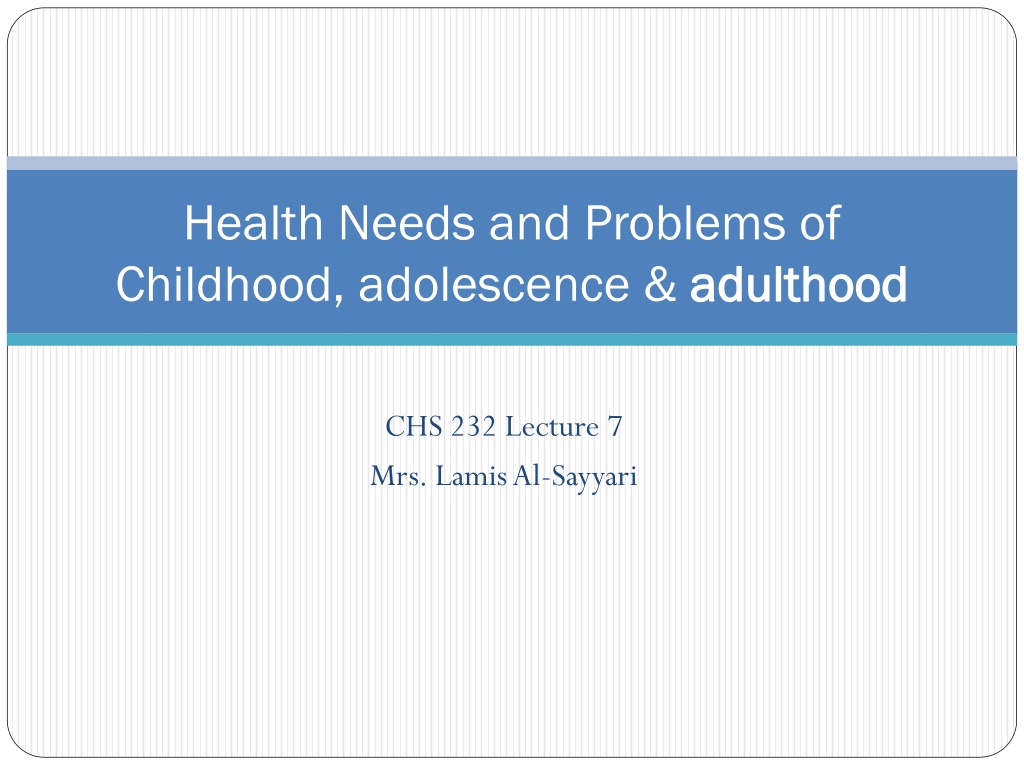
 undefined
undefined






